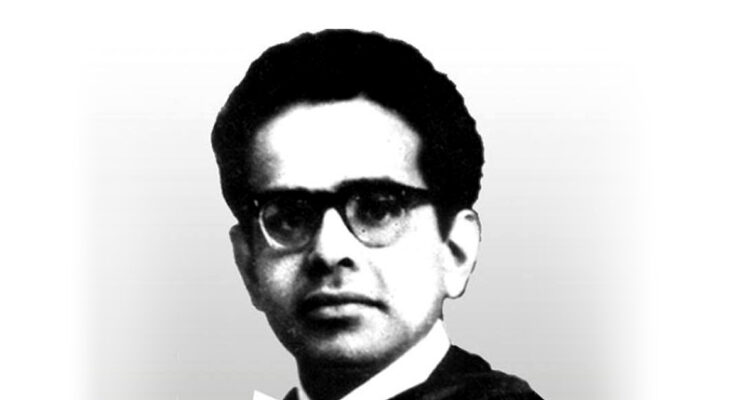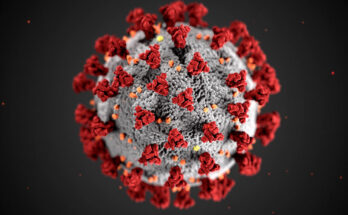Dr. Subhas Mukherjee of India never got recognition in his lifetime. Image Courtesy – Daily Rounds
In the year 1978, on the month of July 25, Dr. Patrick Christopher Steptoe, Dr. Robert Geoffrey Edwards, and Jean Marian Purdy (A British Nurse) got recognition for pioneering the first in vitro fertilization experiment (IVF) in England. The name of the baby was given Louise Joy Brown. Just 67 days later, on October 3, 1978, Dr. Subhash Mukherjee at Kolkata in India got success for India and Asia’s first test-tube baby or in vitro fertilization (IVF). But, instead of recognition, he got insulted and harassed. He was never given recognition from his workplace, instead, he was given a kind of solitary confinement in society as well.
The first part of the story:
June 19, 1981. The story was almost 40 years ago. Teacher Mrs. Namita Mukherjee was returning from her school. She lived with her doctor husband in a six-storey flat on Southern Avenue in Kolkata.
But, Mrs. Namita was not at all ready for what she saw after opening the door of the flat. Her husband’s body hanging from the ceiling! She got a suicide note, “I can’t wait to die of a heart attack,” it said.
Who was that doctor? Let us present the description:
A silent revolution took place in Bengal some 40 years ago! The mastermind of that revolution was the doctor named Dr. Subhas Mukherjee. He is the father of India and Asia’s first test-tube baby or IVF (in vitro fertilization). He was born on January 17, 1931, in the Hazaribagh district of Jharkhand. He spent his student life at Scottish Church College of Kolkata.
He later obtained his MBBS degree from Calcutta National Medical College in 1955. In the same year, he obtained an honorary degree in Physiology from Calcutta University.
He obtained his first Ph.D. degree in Reproductive Physiology in 1958 from Rajabazar Science College, Kolkata. After that, he received his second Ph.D. degree in 1967 by discovering a new method of measuring luteinizing hormone from The University of Edinburgh, UK.
He then joined the Nilratan Sarkar Medical College in Calcutta as a professor. The research on the test-tube baby was in full swing in various laboratories around the world at that time.
Read: Dr. Tapan Kumar Lahiri – A Doctor or An Angel?
Dr. Mukherjee did not have any sophisticated equipment or standard laboratory. It was just talent and indomitable zeal to discover something new. He was assisted by Cryobiologist Dr. Sunit Mukherjee and Gynecologist Dr. Saroj Kanti Bhattacharya. Subhas Mukherjee gradually built the laboratory at Nil Ratan Sircar Medical College and Hospital for long nine years from 1967 to 1976. He always used to stay there addicted to creating a groundbreaking discovery.
Dr. Subhash Mukherjee was a devoted researcher. Who turned his flat into a laboratory. He ignored his greed for private practice easily. He has given up the eternal fascination with child happiness by thinking that it could disrupt his research.
A few days later, he was acquainted with an Agarwal couple of an aristocratic Marwari family. They were still childless 12 years after their marriage. However, after a few days of treatment, Mrs. Bela Agarwal could not get pregnant. On examination, Dr. Subhas Mukherjee saw that both the fallopian tubes of Mrs. Bela Agarwal were blocked. Then he wanted to apply his new research, the test tube baby, to the couple.
On October 3, 1978, Dr. Subhas Mukherjee got success just before the Durga puja. Kanupriya Agarwal was born; her name was given as “Durga”. Kanupriya Agarwal (Durga) was the first test-tube-born child in Asia and India and the second in the world. The first test-tube baby Lewis Joy Brown was born in England just 67 days ago (25 July 1978).
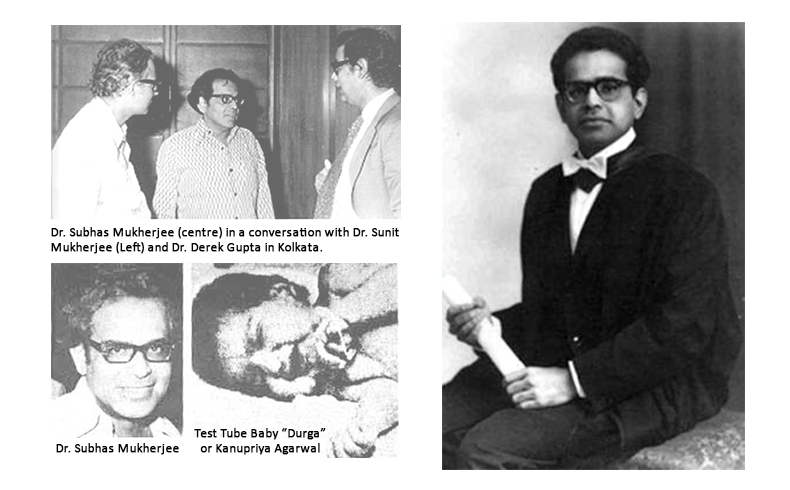
Work process of the superb talented doctor. Image Courtesy – Get Bengal, India Today, India Times
In comparison to the modern types of equipment in England, there was a simple refrigerator in Kolkata, a laboratory with very low space. Dr. Subhas Mukherjee sent the complete research paper to the International Hormone Steroid Congress in New Delhi and also to the Indian Journal of Cryogenics. Then there was a commotion in the medical department of India.
Just after that situation, the humiliation of Dr. Subhas Mukherjee has been started. He did not even get the slightest recognition of his work from his workplace and he was given a kind of solitary confinement in society as if he has done a criminal offense.
Although Robert Edwards won the Nobel Prize for his discovery in 2010 – on the other hand, Dr. Subhash Mukherjee had to face neglect, insult, and humiliation in his own country after his discovery.
There were allegations against Dr. Subhash Mukherjee – why he told the media about his research without informing the department officials. How did he do this with little equipment in his small laboratory, where others could not do with much modern equipment?
Read: Petrol-Diesel from plastic waste is possible now
The Left Front government was the ruling party in West Bengal at that time. On November 18, 1978, the government formed an expert committee under the Medical Association. At the top of the committee, there was a Radio Physicist and the members included a Gynecologist, a Psychologist, a Physicist, and a Neurologist. These members had no idea about modern reproductive technology. The expert committee practically insulted and harassed Dr. Mukherjee by asking many absurd questions. At last, the committee ruled that “Everything that Dr. Subhas Mukherkee claims is bogus.”
After that, an invitation came to Dr. Mukherjee to address an international conference in Japan. Despite being invited to address the international conference and present his work at Kyoto in Japan, Dr. Mukherjee could not appear due to tremendous resistance from the government. His passport was confiscated. He was transferred to Bankura Sanmilani Medical College of West Bengal so that he could not conduct his research work. Despite many requests from Dr. Mukherjee, the health administrators of that time did not revoke the order.
Although he had to join Bankura Sammilani Medical College, he used to return home to Kolkata on the weekends and continued his research in the small laboratory of the hospital. He suffered a heart attack while he was in Bankura. He was then brought back to R. G. Kar Medical College, Kolkata.
But the biggest insult to him happened just a few days before his suicide. In the second week of June 1981, he was transferred to the Institute of Ophthalmology, as a Professor of Electro-Physiology. Not only that all opportunities for his research were strategically taken away. He had to climb up the stairs to the fourth floor every day. Who knows better than doctors how horrible it can be for a heart patient. But, his Ph.D. degree and research were completely different. The talented scientist committed suicide on June 19 without being able to bear the burden of this insult.
On June 19, 1981, his wife Namita Mukherjee returned home from her work and saw that her husband had made the ultimate decision to leave all research. After this incident, Mrs. Namita Mukherjee became paralyzed and spent the rest of her life in bed.
Rampada Chowdhury wrote a novel about the short life of Dr. Subhas Mukherjee called “Abhimanyu”. Later, Tapan Sinha, one of the most prominent Indian film directors, made a film “Ek Doctor Ki Maut” (Death of a Doctor) based on the story of Dr. Subhash Mukherjee. Pankaj Kapur and Shabana Azmi were the main actor and actresses in the film “Ek Doctor Ki Maut”.
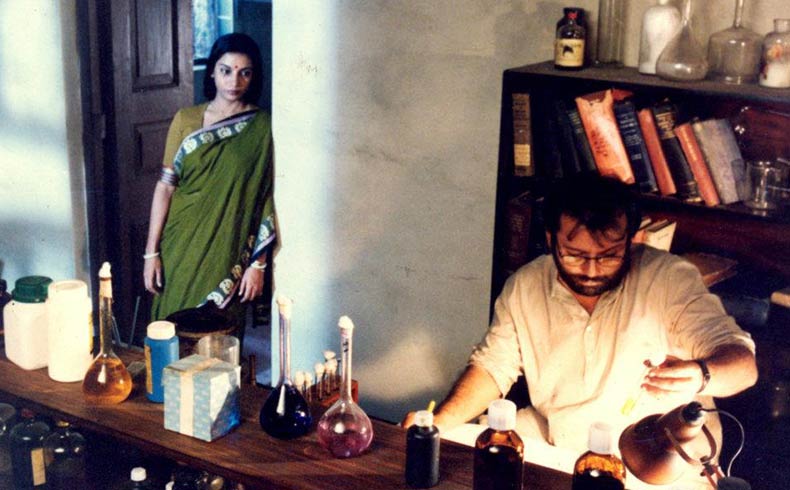
A scene from “Ek Doctor Ki Maut” (Death of A Doctor) an award winning film by Tapan Sinha on the basis of the life story of Dr. Mukherjee. Image Courtesy – Learning and Creativity
The second part of the story:
This part is a little different. On August 16, 1986, another test-tube baby “Harshvardhan Reddy” was born as a result of the research of another scientist T. C. Anand Kumar of India. The Government of India recognized Anand Kumar’s success in creating India’s first test-tube baby. But, that all changed in 1997 when Anand Kumar went to Kolkata to attend a science conference. Dr. Subhas Mukherjee’s note was handed over to him.
Dr. Anand Kumar examined them and talked to Durga’s (Kanupriya Agarwal) parents, he realized that Dr. Mukherjee was the first successful person to conduct research on test-tube babies in India. Then Dr. Anand Kumar confronted the government again. A special committee of 12 members was formed in 2002. Finally, in the year 2003, Dr. Subhash Mukherjee’s research was recognized.
Breaking the silence, “Durga”(Kanupriya Agarwal) also came out publicly on her 25th birthday. Proudly said, “I am not the winner of any game. I am proud to be a living recognition of the hard work of a short-lived genius.” She also said that her parents were severely abused after her birth. She is currently working at Gurgaon, Delhi.
Dr. Subhash Mukherjee’s research ultimately finds seeing the face of light after a long period of neglect and humiliation. Thanks to the dedicated efforts of Anand Kumar. Dr. Subhash Mukherjee was officially recognized as India’s first successful test-tube baby researcher. Dr. Anand Kumar said, “Dr. Subhash must be credited for inventing the first successful test-tube baby in India. The invention of the others is much smaller than his invention.”
In his writings, Dr. Anand Kumar has sharply criticized the inquiry committee formed in 1978. Dr. Anand Kumar said, “None of the four-member inquiry committee had any idea about modern reproductive research, and as a consequence of that Dr. Subhash Mukherjee had to suffer.”
The Economic Times published on 8th October 2018 focused on the 40th birth anniversary celebration of India’s first test-tube baby in Pune. Professor Dr. Sunit Kumar Mukherjee also joined “Durga” or Kanupriya Agarwal’s birthday celebration at the Lions Club International IMA Hall. It was Cryobiologist Dr. Sunit Kumar Mukherjee who worked with Dr. Subhas Mukherjee in the year 1978.
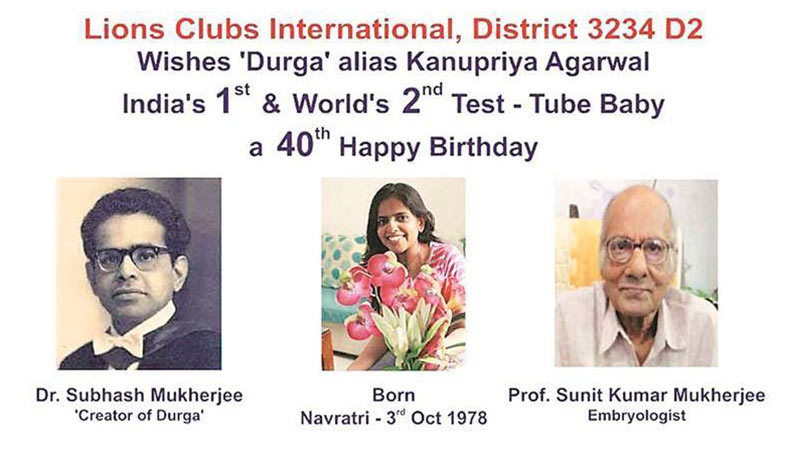
The picture above shows the 40th anniversary of Kanupriya Agarwal published in Indian Express. Image Courtesy – Indian Express
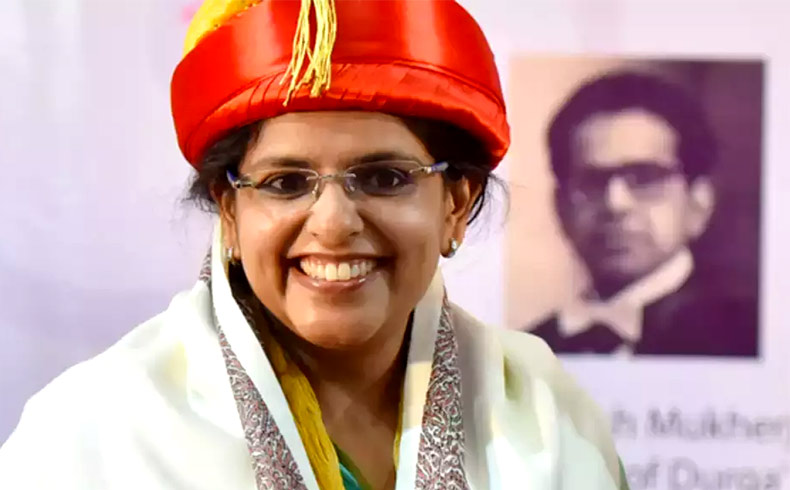
Kanupriya Agarwal in her 40th birth anniversary celebration at the Lions Club International IMA Hall. Image Courtesy – Economic Times
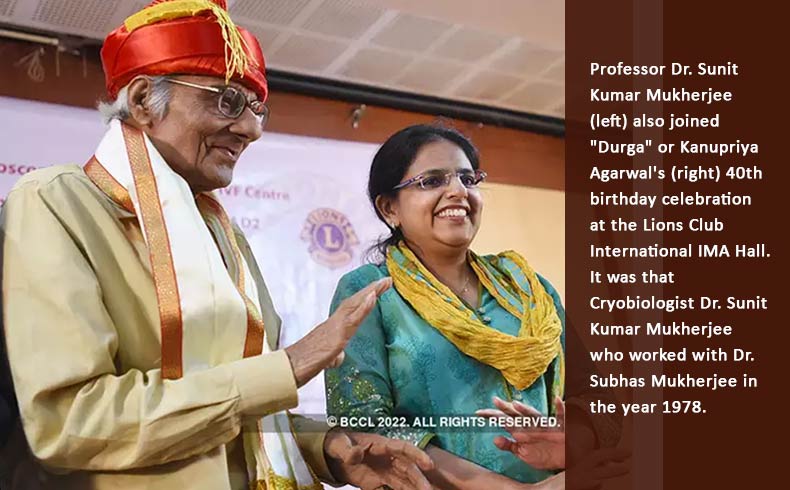
Kanupriya Agarwal(right) in her 40th birth anniversary celebration with Dr. Sunit Kumar Mukherjee (left) who assisted Dr. Subhas Mukherjee for IVF in 1978. Image Courtesy – Economic Times
At present, Dr. Subhash Mukherjee Memorial Reproductive Biology Research Center has been set up in Kolkata. The dormitory of his workplace, Nilratan Sarkar Medical College, has been named after this great scientist 40 years after his death, with a bust sitting there. A memorial plaque has been erected outside the room where he used to conduct his research.
His statue has also been erected in the remote town of Hazaribagh. Even today, many couples hear the call of their child in the way shown by Dr. Mukherjee. But, how much pain such a person has had to go through, is probably beyond our imagination.
In fact, scientists survive in their work. In this connection, it should be noted that in 2010, the Royal Society of Medicine in England published the Dictionary of Medical Biography. The 1100 landmark discoveries in the field of medicine were focused there. There are only 3 names from Kolkata – Sir Ronald Ross, Upendranath Brahmachari, and Dr. Subhas Mukherjee.
We pay our respects to the great soul of India Dr. Subhas Mukherjee.
References:
1. Indian Institute of Oriental Heritage – Facabook Group. It promotes good information and knowledgable posts on astrology, tantra, yoga, darshan, dharma etc.
2. Anandabazar, Roar Bangla, written by Saptarshi Nag
3. The Telegraph Online – Subhash Mukhopadhyay, father of IVF, back home
4. Priyolikha – Dr. Subhash Mukherjee – Bengali creator of Test Tube Baby, an unfortunate medical scientist
5. The Economic Times – Kanupriya Agarwal: India’s first test tube baby celebrates 40th birthday in Pune

